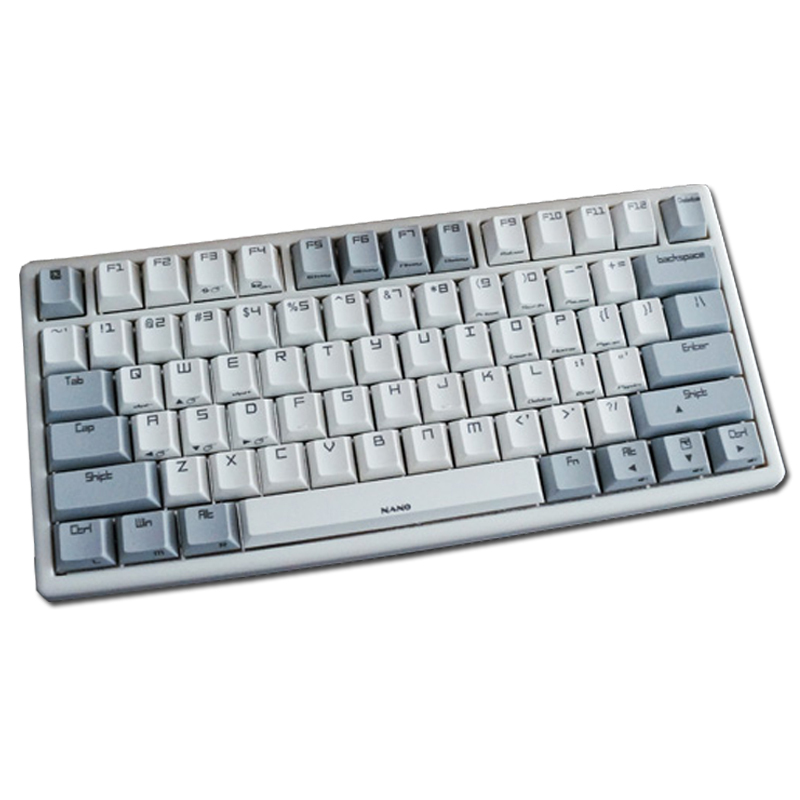
- It should be no wider than a 60% keyboard, to minimize the distance the mouse gets pushed out -- no matter which hand I mouse with (because I can and occasionally do switch)
- It must have dedicated function keys, because while I care immensely about the width, I don't care nearly so much about the depth. This rules out practically all 60% keyboards.
- The stagger is standardized at 1/2 key per row, none of the usual half-quarter-half or even less uniform staggering. This increases comfort when using the overlay modes.
- No tiny keys (smaller than 1 wide or tall), for cost and simplicity -- aside from the toggle switches in the upper right which are not really keys.
- Status LEDs in the relevant keys themselves. Dedicated space for status indicators is a waste.
- Periodic breaks in groups of keys I have to reach for, to facilitate identifying them by touch alone. That means retaining the standard groove (though narrowed) between clusters of four F-keys.
- Both QWERTY and Dvorak legends on keys, except where they are unchanged. (A and M are treated as moving keys even though they don't actually move, because they are functionally similar to keys that do, but the number keys are treated as non-moving.)
- All overlay modes should be an improvement over dedicated keys. To use the cursor keys, there is a momentary thumb tuck to enable the overlay, then the rest of the left hand remains in its usual position (and yes there are two down-arrow keys in the overlay, one for normal WASD-style and the other for 8-direction retro gaming). To use the number pad, there is a thumb tuck and the right hand moves up one row. I would like to have done it without any shift of position, but that leaves no place to put the 0 and . keys.
- No keys omitted, no matter how little I think I might need them.
- Minimal learning curve for someone else to use the keyboard. This means that other than evening out the stagger, most typing keys (and modifiers) don't move. The spacebar gets tiny to make room for the Curs and Num keys, but should still be quite reachable when the left hand is in WASD position for gaming.
- Hardware Dvorak. I don't want to change the OS configuration of someone else's machine just to use my greatly preferred (Dvorak) layout.
- All function toggles are on top, not DIP switches hidden underneath. This is what the four white buttons at upper right are: locking push-toggle switches. The upper two toggle whether or not the Curs and Num keys are allowed to lock, or are reduced to only-when-pressed modifiers. The lower two are the QWERTY/Dvorak switch and the Win-key disable switch. I don't really need a Win-key disable switch, but there is room for four switches and other people do sometimes demand this.
The Dvorak legends would be in a different color (probably green), but I have no way of getting that out of the Keyboard Layout Editor.
I needed a seventh row to squeeze in dedicated (if somewhat inaccessible) PrtSc, ScrLk and Pause keys and my toggles, so the eight Macro keys are just the best use of the remaining space I could think of.
I've also decided that if I'm going to go to the trouble of designing and building everything from the ground up, there's no sense in cutting corners on keys. Thus I've planned to use PBT and dye sublimation for all keys, and the color choices reflect this.
Now for the big question: is there anyone who commercially executes build designs like this? If not, I know I have the skills to assemble something like this, but I'm not so sure about my ability to program it.
Also, would anyone else be interested in such a design, or am I a rare bird who isn't pleased with F-keyless 60% keyboards but still wants minimum width?




